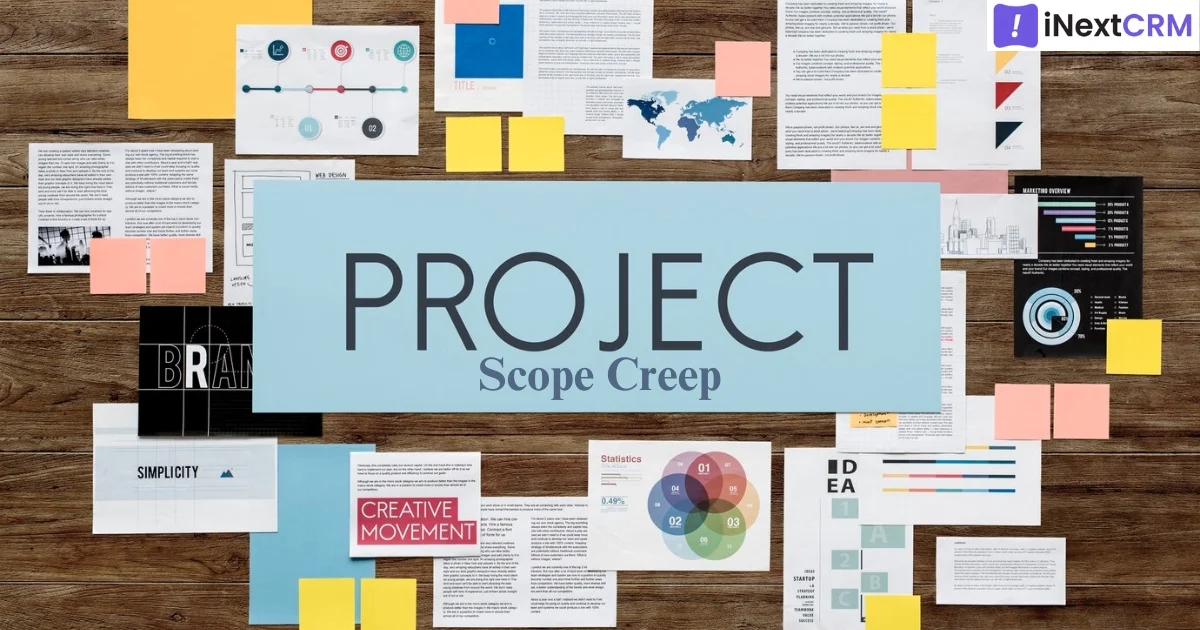As agency owners and freelancers, we’ve all had encounters with the notorious “scope creep.” It’s those seemingly innocent additions to a project that gradually snowball into an unmanageable mess. Not only does it affect project timelines and budgets, but it also threatens client satisfaction. In this comprehensive guide, we’ll explore what scope creep is, its underlying causes, its adverse impact on projects, and most importantly, how agencies and freelancers can navigate this challenging terrain to turn it into an opportunity for increased revenue.

The Dreaded Scope Creep
What is Scope Creep?
Scope creep, also known as “requirement creep” or “feature creep,” occurs when the requirements of a project gradually expand beyond their initial definition. Picture a project that starts as a simple concept, but over time, it balloons into something far more complex and resource-intensive than originally planned.
For instance, what began as a single deliverable may morph into five; a software product initially designed with three essential features may suddenly demand ten. Sometimes, clients’ needs change mid-project, necessitating a complete reassessment of the project’s scope.
Scope creep is a common woe for agencies across various sectors, including Marketing & Advertising, IT, and Consultancy. Surprisingly, it siphons away about 15-17% of an agency or freelancer’s income.
Causes of Scope Creep
Scope creep can be triggered by various factors, and some of the common causes include:
- Poorly Defined Objectives and Requirements: When project objectives and requirements lack clarity, stakeholders may easily request additional features or changes not initially part of the plan. This ambiguity opens the door to scope creep.
- Inadequate Communication: Effective communication is pivotal in managing project scope. Without transparent communication between the project team and stakeholders, it’s difficult to evaluate and approve changes or additions to the scope. This communication gap can breed scope creep.
- Lack of Proper Change Control Processes: Change control processes play a vital role in scope management. Without well-defined change control mechanisms, assessing and approving scope changes becomes a daunting task, paving the way for scope creep. Studies show that projects utilizing change control mechanisms, often facilitated by client management software, experience a significant decrease in scope creep.
- Inaccurate Initial Project Estimates: Inaccurate initial estimates can throw off project management efforts, making it hard to control the project scope effectively. Unrealistic expectations and unaccounted-for new requirements can emerge due to these inaccurate estimates.
Addressing the root causes of scope creep is essential for crafting effective prevention strategies. By acknowledging these causes and implementing robust project management techniques, agencies and freelancers can curtail the occurrence of scope creep and ensure the successful completion of their projects.
Impact of Scope Creep on Projects

Scope creep can have severe consequences, affecting both the project timeline and budget, and straining resources.
Effects on Project Timeline
Additional requirements or features tacked onto a project often lead to delays in project completion. As the project team diverts attention to accommodate the expanded scope, the original timeline may become unfeasible.
Consider a software development project with a clear scope and a well-defined timeline. As the project progresses, stakeholders start requesting additional functionalities and modifications. These changes necessitate extra analysis, design, coding, and testing efforts, all of which take time. The project team, already working at full capacity, must now juggle between the original tasks and the new requirements, leading to a stretched timeline.
Moreover, scope creep can trigger a domino effect. Delays caused by accommodating one change can ripple through subsequent tasks and deadlines, further exacerbating the project timeline and resulting in missed deadlines.
Effects on Budget and Resources
Scope creep can significantly impact project costs and resource allocation. Additional work not initially planned consumes additional resources, straining the project budget.
Imagine a construction project with a meticulously planned budget. However, as the project unfolds, the client requests changes to the building design, materials, or layout. These changes require extra materials, labor, and may disrupt the existing workflow. The project team may need to hire additional workers, purchase new materials, or subcontract specialized services, all of which incur extra costs.
Uncontrolled scope creep can lead to overspending and reallocation of resources from other project areas. If the project budget is exceeded due to scope creep, the project manager might have to cut costs from other critical areas, such as training, quality assurance, or equipment upgrades. This can create an imbalance in resource allocation, compromising overall project efficiency.
Additionally, scope creep can impact resource availability. As the project team dedicates time to accommodate additional requirements, their availability for other essential project tasks may be compromised. This can result in delays in parallel projects or necessitate the hiring of additional resources, further straining the project budget.
Strategies to Avoid Scope Creep
Preventing scope creep begins with establishing clear project definitions, effective communication channels, and engaging stakeholders throughout the project lifecycle.

- Clear Project Definition
A well-defined project scope statement and requirements document are critical in managing scope creep. These documents outline project objectives, deliverables, and limitations, providing a clear boundary for project activities. They serve as a reference point for all stakeholders involved in the project, ensuring everyone is aligned regarding project expectations.
Regularly reviewing and revising these documents during the project lifecycle can help prevent scope expansion. As the project progresses, new requirements may emerge, and existing requirements may need modification. By actively managing these changes and updating the project definition accordingly, project managers maintain control over the project scope.
Furthermore, involving key stakeholders in the review and approval process of the project’s scope definition fosters a sense of ownership and accountability among stakeholders, reducing the likelihood of scope creep.
- Effective Communication
Open and transparent communication is vital for managing expectations and minimizing scope creep. Project managers should establish effective communication channels with all stakeholders, including clients, project team members, and senior management.
Regularly engaging with stakeholders, conducting status meetings, and providing timely project updates can help identify potential scope issues early on. By keeping stakeholders informed about the project’s progress, challenges, and potential risks, project managers can address concerns proactively and make necessary adjustments to the project scope.
Encouraging feedback and addressing concerns promptly ensures that project expectations align with reality. When stakeholders feel heard and involved in the decision-making process, they are less likely to introduce unnecessary changes leading to scope creep.
- Stakeholder Engagement
Involving stakeholders throughout the project can help prevent scope creep. Engaging stakeholders in project discussions, decision-making, and requirements gathering ensures their expectations and needs are considered effectively.
By actively involving stakeholders, project managers gain valuable insights into their requirements, preferences, and constraints. This information can be used to develop a comprehensive project plan that addresses stakeholders’ needs while maintaining a realistic and achievable scope.
Furthermore, their active participation increases stakeholder buy-in and reduces the likelihood of scope changes later in the project. When stakeholders are involved from the early stages of the project, they have a sense of ownership and commitment to the project’s success, reducing the chances of scope creep.
Techniques for Managing Scope Creep
While prevention is ideal, scope creep can still occur despite efforts to prevent it. Having effective techniques in place for managing scope changes is crucial to minimize the impact.
- Change Control Process
Implementing a formal change control process enables project teams to evaluate and manage requested scope changes effectively. This process typically involves documenting and reviewing change requests, assessing their impact on project objectives, and obtaining appropriate approvals. By using this process, project managers can assess the feasibility and impact of any proposed scope change before accepting it.
Consider creating a change request form for your clients. It should include questions like:
- What impact will this change have?
- What priority should this change take among existing tasks?
- What are the benefits of this change?
This form encourages clients to think critically about the proposed change’s impact, helping to reduce unnecessary scope expansion.
- Priority Matrix
Establish a priority matrix with your clients at the project’s outset. This matrix ranks Budget, Timeline, and Scope in descending order of importance. It also clarifies which aspects are non-negotiable later in the project.
If, for instance, the client prioritizes Budget or Timeline as the top concern and labels them as non-negotiable, you can use this as leverage. Any scope changes can be explained as potential threats to Budget or Timeline, reinforcing the importance of sticking to the original plan.
- Regular Project Reviews
Frequent project reviews are essential to spot scope creep early. By regularly assessing progress against predefined goals and objectives, project managers can identify deviations from the original scope and take corrective actions promptly.
Clientjoy’s Client Portal simplifies project management by embedding project management boards, scope documents, onboarding documents, feedback forms, OneDrive folders with assets, weekly reports, drafts, and more. This consolidated approach empowers clients to access relevant information in one place, facilitating well-informed decisions.
- Prioritizing Project Requirements
Prioritizing project requirements can help manage scope creep effectively. By categorizing requirements based on their importance, project managers can allocate resources to deliver critical features while minimizing efforts on low-priority aspects. This approach ensures that excessive time and resources aren’t spent on less important requirements, reducing the scope’s expansion.
The Golden Statement
Incorporate a clause in your email or agreement stating, “Any additional effort shall be charged as per the requirement.” This simple line serves as a safety net to safeguard against scope creep.
Scope creeps often rear their heads when significant project progress has been made. Agencies and freelancers, who have invested considerable time, might find it challenging to backtrack and often agree to scope changes. In such situations, the Golden Statement provides a way to maintain project focus and avoid unnecessary scope expansion.
Conclusion
In conclusion, effective scope management is pivotal for project success. Understanding the root causes and impact of scope creep, coupled with preventive strategies and management techniques, empowers agencies and freelancers to navigate this challenge successfully. By proactively managing and addressing scope changes and actively engaging stakeholders throughout the project, the likelihood of scope creep diminishes.
For a comprehensive CRM solution or business automation service, feel free to reach out to us at biz@inextcrm.com or call/WhatsApp us at +91-7506506672. We’re here to assist you in optimizing your business processes and ensuring project success.


